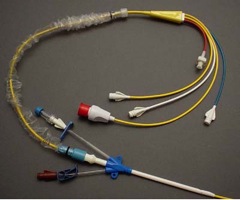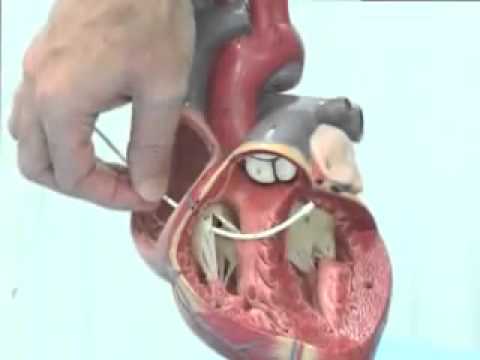Swanz Ganz catheter or pulmonary artery catheter (PAC), also called right heart catheter is a very thin catheter that is inserted into your heart’s right side as well as the arteries that lead to your lungs. Its basic function is to check your heart’s blood flow and function. Swan Ganz catheterization refers to the insertion of the Swan Ganz into your heart. However, this procedure is executed in extremely sick patients. Here’s all you need to know about swan ganz catheter interpretation.
Description of the Swan Ganz Catheter
 The Swan Ganz catheter comes in several sizes for children as well as adults. Its length range is from 60cm to 110cm and has a 4 degree Fahrenheit to 8 degree Fahrenheit caliber. The volume of the balloon inflation ranges from about 0.5ml to 1.5ml. Furthermore, it is manufactured using polyvinyl chloride. This material is quite pliable at the normal room temperature, but softens at the body temperature. Markings at the catheter are made at every 10cm interval to assist insertion of the catheter.
The Swan Ganz catheter comes in several sizes for children as well as adults. Its length range is from 60cm to 110cm and has a 4 degree Fahrenheit to 8 degree Fahrenheit caliber. The volume of the balloon inflation ranges from about 0.5ml to 1.5ml. Furthermore, it is manufactured using polyvinyl chloride. This material is quite pliable at the normal room temperature, but softens at the body temperature. Markings at the catheter are made at every 10cm interval to assist insertion of the catheter.
The Swan Ganz catheters also come with a syringe plunger, introducer that serves as a fast infuser, slide locking mechanism, markings that designate the distance from its tip, connectors for the monitor, lumens and 8 French polyvinyl chloride yellow colored catheters as well as 5 lumens in different colors.
The following video has detailed and easy to understand pulmonary artery or swan ganz catheter interpretation, including functions of different parts and how to use.
Why Is a Swan Ganz Catheter Used?
A Swan Ganz catheter is used for evaluating the thermodynamics of blood when it moves through your lungs and heart into your body. It is mostly used for checking the presence of any complication in your kidneys, lungs or heart. Additionally, this procedure evaluates the following as well:
- Heart function that follows after a cardiac arrest
- Heart failure
- Fluid in the lungs or pulmonary edema
- Shock
- Valvular heart disease aka leaky heart valves
- Congenital heart condition
- Pulmonary hypertension
- Cardiomyopathy
- Post-op checking of the patients of open-heart surgeries
Moreover, Swan Ganz catheters are also used in combination with IV. Medications used for cardiovascular conditions. Notably, the effects and impacts ofthese drugs are monitored and tested via the Swan Ganz catheter.
Besides, the Swan Ganz catheterization is also at times employed in arrangement with endocardial biopsy. It is the exclusion of your heart tissue’s tiny portion, so your heart can be prepared for heart transplant. The pressure of the pulmonary heart needs to be extremely low for the recipient of the heart transplant. The Swan Ganz catheter helps determine whether or not medications are required for lowering the blood pressure.
How Is a Swan Ganz Catheterization Performed?
 To prepare, you should not drink or eat anything 8 hours before the procedure and also follow other instructions from the doctor. The Swan Ganz catheter is normally inserted when you are admitted in a hospital’s intensive care special unit. First, you are given some sedative that will calm you down, but will not make you unconscious. Next, the region where the Swan Ganz catheter is supposed to be attached will be properly shaved and cleaned. Yet, it will be numbed using local anesthesia.
To prepare, you should not drink or eat anything 8 hours before the procedure and also follow other instructions from the doctor. The Swan Ganz catheter is normally inserted when you are admitted in a hospital’s intensive care special unit. First, you are given some sedative that will calm you down, but will not make you unconscious. Next, the region where the Swan Ganz catheter is supposed to be attached will be properly shaved and cleaned. Yet, it will be numbed using local anesthesia.
Afterwards, your doctor will cut a little portion of your skin for enabling the Swan Ganz catheter to enter your body via a vein. An empty, hollow tube known as the ‘introducer sheath’ will be inserted into that vein first. It enables the Swan Ganz to conveniently enter the body. The Swan Ganz is directed via the veins into your heart’s right side. Therefore, your doctor will check your blood’s pressure in your pulmonary artery. They might take a sample of the blood for checking the blood oxygen concentration. Sometimes, medications are given to examine the response of your heart to the Swan Ganz.
Once all the exams are completed, the Swan Ganz will be taken out of the body. The wound of its incision will be properly closed with sutures or stitches. Later on, your heart rate will be monitored very closely during the entire procedure via the EKG (electrocardiogram) machine. You would be awake throughout the entire procedure, but will probably not feel any pain. However, you might feel a little pressure at the point when the Swan Ganz is pushed in your body.
How long the catheter will stay inside the body depends entirely on the condition of the patient. Extremely ill patients often have to bear the Swan Ganz for a couple of days at times.
Pulmonary Artery (Swan Ganz) Catheter Insertion:
Swan-Ganz Catheterization Risks
Swan ganz catheter interpretation is not complete without understanding the risks and controversy over this procedure, here’s more:
Controversy Surrounding Swan-Ganz Catheterization

